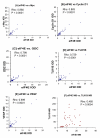Tissue microarray analysis of eIF4E and its downstream effector proteins in human breast cancer
- PMID: 19134194
- PMCID: PMC2631459
- DOI: 10.1186/1756-9966-28-5
Tissue microarray analysis of eIF4E and its downstream effector proteins in human breast cancer
Erratum in
- J Exp Clin Cancer Res. 2009;28:54
Abstract
Background: Eukaryotic initiation factor 4E (eIF4E) is elevated in many cancers and is a prognostic indicator in breast cancer. Many pro-tumorigenic proteins are selectively translated via eIF4E, including c-Myc, cyclin D1, ornithine decarboxylase (ODC), vascular endothelial growth factor (VEGF) and Tousled-like kinase 1B (TLK1B). However, western blot analysis of these factors in human breast cancer has been limited by the availability of fresh frozen tissue and the labor-intensive nature of the multiple assays required. Our goal was to validate whether formalin-fixed, paraffin-embedded tissues arranged in a tissue microarray (TMA) format would be more efficient than the use of fresh-frozen tissue and western blot to test multiple downstream gene products.
Results: Breast tumor TMAs were stained immunohistochemically and quantitated using the ARIOL imaging system. In the TMAs, eIF4E levels correlated strongly with c-Myc, cyclin D1, TLK1B, VEGF, and ODC. Western blot comparisons of eIF4E vs. TLK1B were consistent with the immunohistochemical results. Consistent with our previous western blot results, eIF4E did not correlate with node status, ER, PR, or HER-2/neu.
Conclusion: We conclude that the TMA technique yields similar results as the western blot technique and can be more efficient and thorough in the evaluation of several products downstream of eIF4E.
Figures




References
-
- Jemal A, Siegel R, Ward E, Murray T, Xu J, Thun MJ. Cancer statistics, 2007. CA Cancer J Clin. 2007;57:43–66. - PubMed
Publication types
MeSH terms
Substances
Grants and funding
LinkOut - more resources
Full Text Sources
Medical
Research Materials
Miscellaneous

